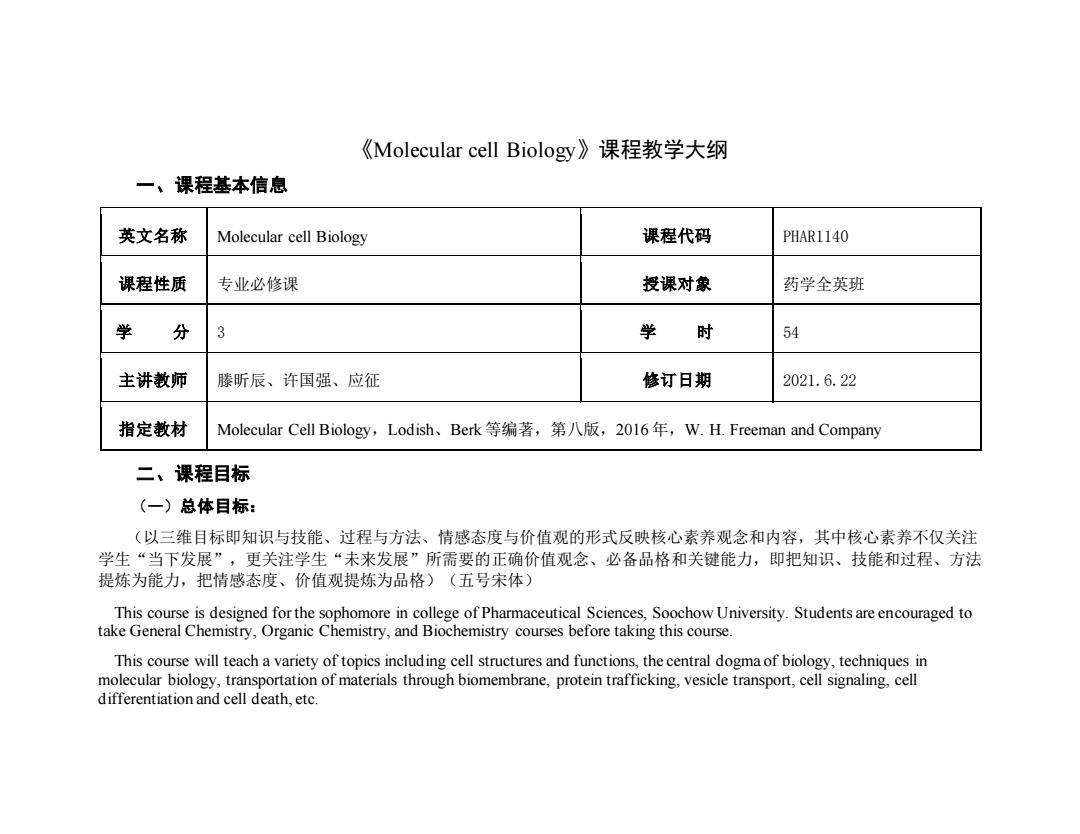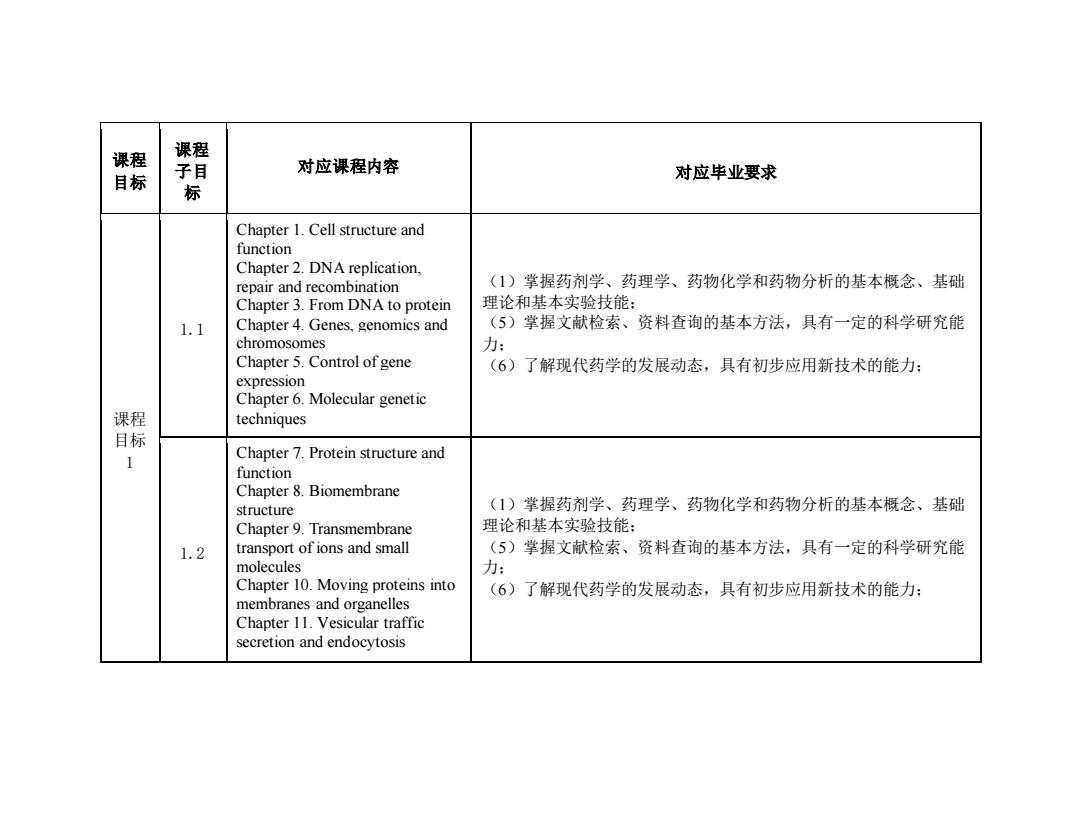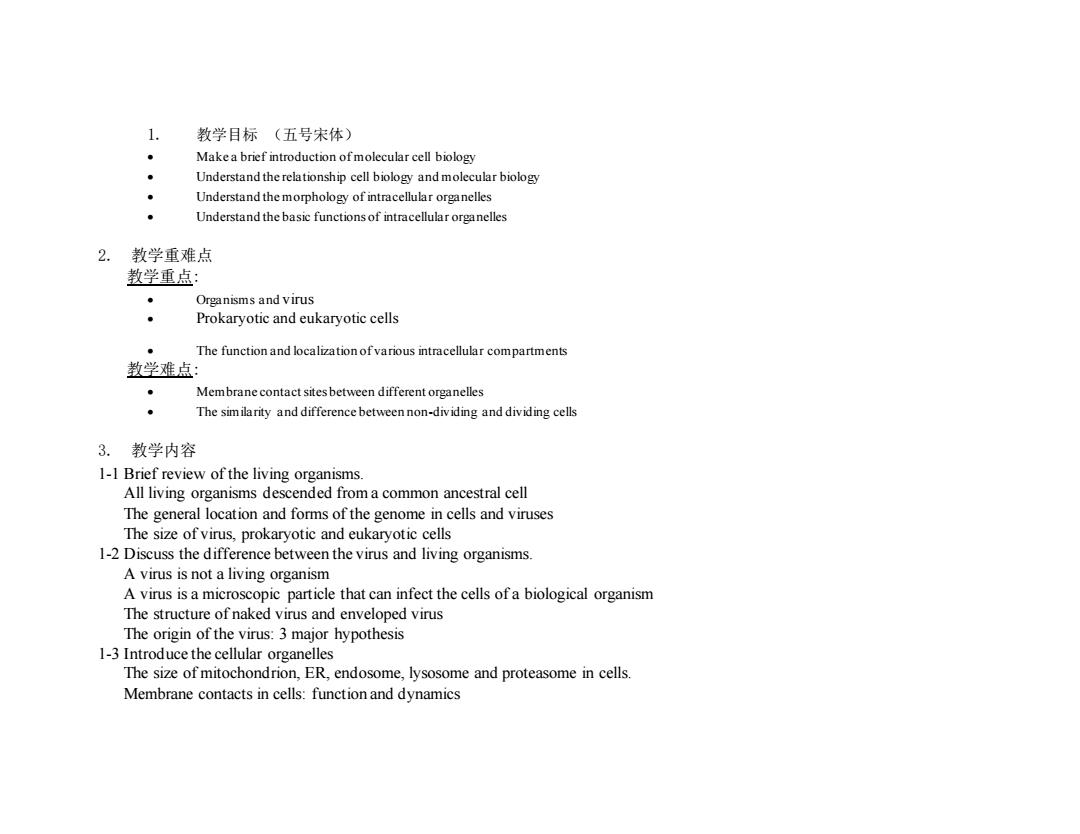
《Molecular cell Biology》课程教学大纲 一、课程基本信息 英文名称 Molecular cell Biology 课程代码 PHAR1140 课程性质 专业必修课 授课对象 药学全英班 学 分 3 学 时 54 主讲教师 滕昕辰、许国强、应征 修订日期 2021.6.22 指定教材 Molecular Cell Biology,Lodish、Berk等编著,第八版,2016年,W.H.Freeman and Company 二、课程目标 (一)总体目标: (以三维目标即知识与技能、过程与方法、情感态度与价值观的形式反映核心素养观念和内容,其中核心素养不仅关注 学生“当下发展”,更关注学生“未来发展”所需要的正确价值观念、必备品格和关键能力,即把知识、技能和过程、方法 提炼为能力,把情感态度、价值观提炼为品格)(五号宋体) This course is designed for the sophomore in college of Pharmaceutical Sciences,Soochow University.Students are encouraged to take General Chemistry,Organic Chemistry,and Biochemistry courses before taking this course. This course will teach a variety of topics including cell structures and functions,the central dogma of biology,techniques in molecular biology,transportation of materials through biomembrane,protein trafficking,vesicle transport,cell signaling,cell differentiation and cell death,etc
《Molecular cell Biology》课程教学大纲 一、课程基本信息 英文名称 Molecular cell Biology 课程代码 PHAR1140 课程性质 专业必修课 授课对象 药学全英班 学 分 3 学 时 54 主讲教师 滕昕辰、许国强、应征 修订日期 2021.6.22 指定教材 Molecular Cell Biology,Lodish、Berk 等编著,第八版,2016 年,W. H. Freeman and Company 二、课程目标 (一)总体目标: (以三维目标即知识与技能、过程与方法、情感态度与价值观的形式反映核心素养观念和内容,其中核心素养不仅关注 学生“当下发展”,更关注学生“未来发展”所需要的正确价值观念、必备品格和关键能力,即把知识、技能和过程、方法 提炼为能力,把情感态度、价值观提炼为品格)(五号宋体) This course is designed for the sophomore in college of Pharmaceutical Sciences, Soochow University. Students are encouraged to take General Chemistry, Organic Chemistry, and Biochemistry courses before taking this course. This course will teach a variety of topics including cell structures and functions, the central dogma of biology, techniques in molecular biology, transportation of materials through biomembrane, protein trafficking, vesicle transport, cell signaling, cell differentiation and cell death, etc

The objective of the course is to help students to understand the advanced principles in molecular biology,cell biology,and cell signaling.After taking this course,the students should be able to know the major principles and techniques in the above fields.They should also be able to use these techniques for their thesis work. (二)课程目标: (课程目标规定某一阶段的学生通过课程学习以后,在发展德、智、体、美、劳等方面期望实现的程度,它是确定课程 内容、教学目标和教学方法的基础。)(五号宋体) 课程目标1: 1.1 To learn the cell structures and functions,the central dogma of biology,and techniques in molecular biology 1.2 To understand the different ways and models for the transportation of materials through biomembrane,protein trafficking,and vesicle transport. 1.3 To know the major signaling pathways in cell signaling,cell differentiation and cell death. 课程目标2: 2.1 To improve reading,listening,writing in English 2.2 To learn course materials in English 2.3 To improve the communication skills in English (要求参照《普通高等学校本科专业类教学质量国家标准》,对应各类专业认证标准,注意对毕业要求支撑程度强弱的 描述,与“课程目标对毕业要求的支撑关系表一致)(五号宋体) (三)课程目标与毕业要求、课程内容的对应关系(小四号黑体) 表1:课程目标与课程内容、华业要求的对应关系表(五号宋体)
The objective of the course is to help students to understand the advanced principles in molecular biology, cell biology, and cell signaling. After taking this course, the students should be able to know the major principles and techniques in the above fields. They should also be able to use these techniques for their thesis work. (二)课程目标: (课程目标规定某一阶段的学生通过课程学习以后,在发展德、智、体、美、劳等方面期望实现的程度,它是确定课程 内容、教学目标和教学方法的基础。)(五号宋体) 课程目标 1: 1.1 To learn the cell structures and functions, the central dogma of biology, and techniques in molecular biology 1.2 To understand the different ways and models for the transportation of materials through biomembrane, protein trafficking, and vesicle transport. 1.3 To know the major signaling pathways in cell signaling, cell differentiation and cell death. 课程目标 2: 2.1 To improve reading, listening, writing in English. 2.2 To learn course materials in English. 2.3 To improve the communication skills in English. (要求参照《普通高等学校本科专业类教学质量国家标准》,对应各类专业认证标准,注意对毕业要求支撑程度强弱的 描述,与“课程目标对毕业要求的支撑关系表一致)(五号宋体) (三)课程目标与毕业要求、课程内容的对应关系(小四号黑体) 表 1:课程目标与课程内容、毕业要求的对应关系表 (五号宋体)

课程 课程 对应课程内容 目标 对应毕业要求 标 Chapter 1.Cell structure and function Chapter 2.DNA replication. repair and recombination (1)掌握药剂学、药理学、药物化学和药物分析的基本概念、基础 Chapter 3.From DNA to protein 理论和基本实验技能: 1.1 Chapter 4.Genes,genomics and (5)掌握文献检索、资料查询的基本方法,具有一定的科学研究能 chromosomes 力: Chapter 5.Control of gene (6)了解现代药学的发展动态,具有初步应用新技术的能力: expression Chapter 6.Molecular genetic 课程 techniques 目标 1 Chapter 7.Protein structure and function Chapter 8.Biomembrane structure (1)掌握药剂学、药理学、药物化学和药物分析的基本概念、基础 Chapter 9.Transmembrane 理论和基本实验技能: 1.2 transport of ions and small (5)掌握文献检索、资料查询的基本方法,具有一定的科学研究能 molecules 力: Chapter 10.Moving proteins into (6)了解现代药学的发展动态,具有初步应用新技术的能力: membranes and organelles Chapter 11.Vesicular traffic secretion and endocytosis
课程 目标 课程 子目 标 对应课程内容 对应毕业要求 课程 目标 1 1.1 Chapter 1. Cell structure and function Chapter 2. DNA replication, repair and recombination Chapter 3. From DNA to protein Chapter 4. Genes, genomics and chromosomes Chapter 5. Control of gene expression Chapter 6. Molecular genetic techniques (1)掌握药剂学、药理学、药物化学和药物分析的基本概念、基础 理论和基本实验技能; (5)掌握文献检索、资料查询的基本方法,具有一定的科学研究能 力; (6)了解现代药学的发展动态,具有初步应用新技术的能力; 1.2 Chapter 7. Protein structure and function Chapter 8. Biomembrane structure Chapter 9. Transmembrane transport of ions and small molecules Chapter 10. Moving proteins into membranes and organelles Chapter 11. Vesicular traffic secretion and endocytosis (1)掌握药剂学、药理学、药物化学和药物分析的基本概念、基础 理论和基本实验技能; (5)掌握文献检索、资料查询的基本方法,具有一定的科学研究能 力; (6)了解现代药学的发展动态,具有初步应用新技术的能力;

Chapter 12.Cell signaling (1)掌握药剂学、药理学、药物化学和药物分析的基本概念、基础 Chapter 13.The cytoskeleton Chapter 14.Cell cycle 理论和基本实验技能: 1.3 Chapter 15.Integrating cells into (5)掌握文献检索、资料查询的基本方法,具有一定的科学研究能 tissues 力: Chapter 16.Cell differentiation and cell death (6)了解现代药学的发展动态,具有初步应用新技术的能力: (7)具备一定的英语听、说、读、写能力,能够阅读本专业相关外 2.1 Chapter 1-16. 文资料,英语水平达到《苏州大学普通高等教育本科毕业生学士学 位授予工作实施细则(2017年修订)》 课程 (7)具备一定的英语听、说、读、写能力,能够阅读本专业相关外 目标 2.2 Chapter 1-16. 文资料,英语水平达到《苏州大学普通高等教育本科毕业生学士学 2 位授予工作实施细则(2017年修订)》 (7)具备一定的英语听、说、读、写能力,能够阅读本专业相关外 2.3 Chapter 1-16. 文资料,英语水平达到《苏州大学普通高等教育本科毕业生学士学 位授予工作实施细则(2017年修订)》 (大类基础课程、专业教学课程及开放选修课程按照本科教学手册中各专业拟定的毕业要求填写“对应毕业要求”栏。 通识教育课程含通识选修课程、新生研讨课程及公共基础课程,面向专业为工科、师范、医学等有专业认证标准的专业,按 照专业认证通用标准填写“对应毕业要求”栏:面向其他尚未有专业认证标准的专业,按照本科教学手册中各专业拟定的毕 业要求填写“对应毕业要求”栏。) 三、教学内容(四号黑体) Chapter 1..Cell structure and function(应征)
1.3 Chapter 12. Cell signaling Chapter 13. The cytoskeleton Chapter 14. Cell cycle Chapter 15. Integrating cells into tissues Chapter 16. Cell differentiation and cell death (1)掌握药剂学、药理学、药物化学和药物分析的基本概念、基础 理论和基本实验技能; (5)掌握文献检索、资料查询的基本方法,具有一定的科学研究能 力; (6)了解现代药学的发展动态,具有初步应用新技术的能力; 课程 目标 2 2.1 Chapter 1-16. (7)具备一定的英语听、说、读、写能力,能够阅读本专业相关外 文资料,英语水平达到《苏州大学普通高等教育本科毕业生学士学 位授予工作实施细则(2017 年修订)》 2.2 Chapter 1-16. (7)具备一定的英语听、说、读、写能力,能够阅读本专业相关外 文资料,英语水平达到《苏州大学普通高等教育本科毕业生学士学 位授予工作实施细则(2017 年修订)》 2.3 Chapter 1-16. (7)具备一定的英语听、说、读、写能力,能够阅读本专业相关外 文资料,英语水平达到《苏州大学普通高等教育本科毕业生学士学 位授予工作实施细则(2017 年修订)》 (大类基础课程、专业教学课程及开放选修课程按照本科教学手册中各专业拟定的毕业要求填写“对应毕业要求”栏。 通识教育课程含通识选修课程、新生研讨课程及公共基础课程,面向专业为工科、师范、医学等有专业认证标准的专业,按 照专业认证通用标准填写“对应毕业要求”栏;面向其他尚未有专业认证标准的专业,按照本科教学手册中各专业拟定的毕 业要求填写“对应毕业要求”栏。) 三、教学内容(四号黑体) Chapter 1. Cell structure and function(应征)

1. 教学目标(五号宋体) Make a brief introduction of molecular cell biology Understand the relationship cell biology and molecular biology Understand the morphology of intracellular organelles Understand the basic functions of intracellular organelles 2. 教学重难点 教学重点 Organisms and virus Prokaryotic and eukaryotic cells ● The function and localization of various intracellular compartments 教学难点: Membrane contact sites between different organelles The similarity and difference between non-dividing and dividing cells 3.教学内容 1-1 Brief review of the living organisms. All living organisms descended from a common ancestral cell The general location and forms of the genome in cells and viruses The size of virus,prokaryotic and eukaryotic cells 1-2 Discuss the difference between the virus and living organisms. A virus is not a living organism A virus is a microscopic particle that can infect the cells of a biological organism The structure of naked virus and enveloped virus The origin of the virus:3 major hypothesis 1-3 Introduce the cellular organelles The size of mitochondrion,ER,endosome,lysosome and proteasome in cells. Membrane contacts in cells:function and dynamics
1. 教学目标 (五号宋体) • Make a brief introduction of molecular cell biology • Understand the relationship cell biology and molecular biology • Understand the morphology of intracellular organelles • Understand the basic functions of intracellular organelles 2. 教学重难点 教学重点: • Organisms and virus • Prokaryotic and eukaryotic cells • The function and localization of various intracellular compartments 教学难点: • Membrane contact sites between different organelles • The similarity and difference between non-dividing and dividing cells 3. 教学内容 1-1 Brief review of the living organisms. All living organisms descended from a common ancestral cell The general location and forms of the genome in cells and viruses The size of virus, prokaryotic and eukaryotic cells 1-2 Discuss the difference between the virus and living organisms. A virus is not a living organism A virus is a microscopic particle that can infect the cells of a biological organism The structure of naked virus and enveloped virus The origin of the virus: 3 major hypothesis 1-3 Introduce the cellular organelles The size of mitochondrion, ER, endosome, lysosome and proteasome in cells. Membrane contacts in cells: function and dynamics